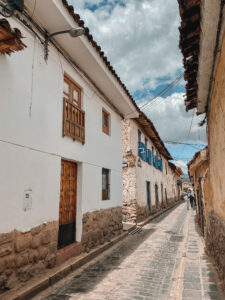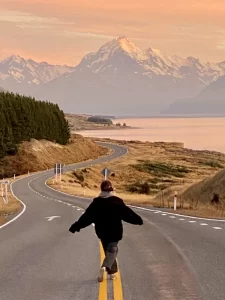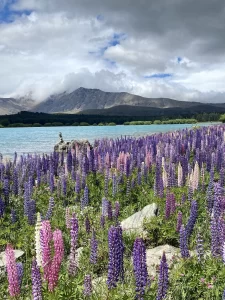Rainbow Mountain, also known as Vinicunca or Montaña de Siete Colores, is a high altitude mountain in the Peruvian Andes that you’ve probably seen on Instagram. It has become one of the most popular tourist attractions in South America due to its unique coloring and stunning views. But there’s more to the Rainbow Mountain hike than meets the eye — extreme overtourism, strain on local populations, and unmatched expectations have put a bad taste in many travelers’ mouths.
Here is the truth behind what happens on this popular day trip, including things to consider before visiting and alternative treks to do instead!
Disclosure: Some of the links below are affiliate links. When you purchase through links on my site, I may make a small commission (at no extra cost to you!).
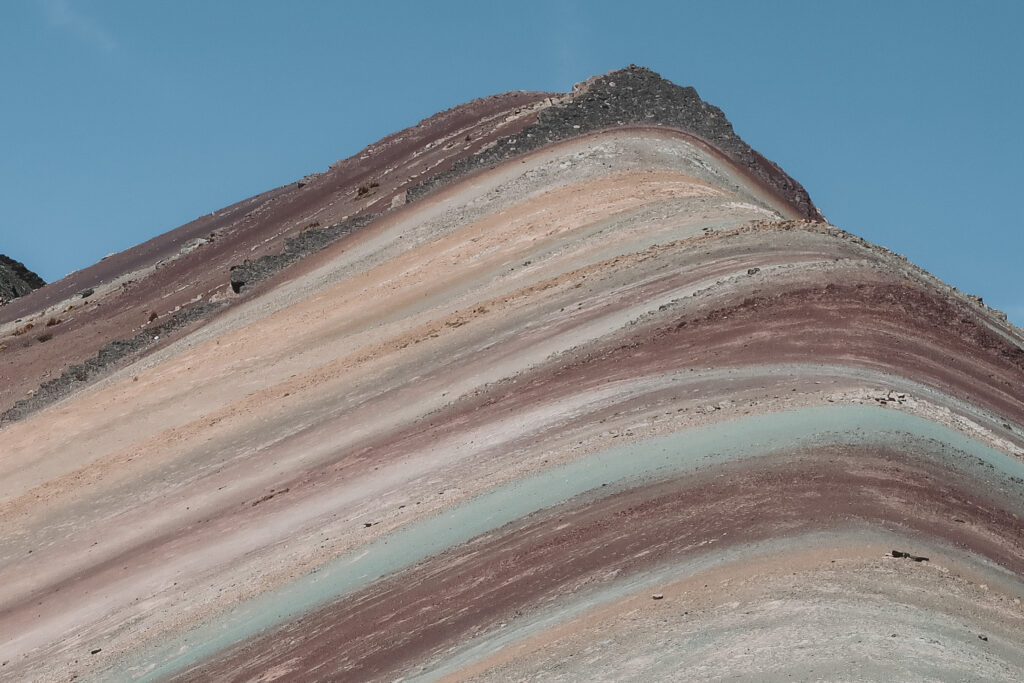
About Rainbow Mountain Peru
Quick facts
- Alternative names: Vinicunca, Winikunka, Montaña de Siete Colores, Mountain of Seven Colors
- Location: Andes mountain range, Cusco region of Peru
- Rainbow Mountain Peru elevation: 5,200 m (17,060 ft) above sea level
- Distance: 7 km (4.3 mi)
- Duration: 3-4 hours roundtrip
- Difficulty: Moderate to difficult, depending on fitness and acclimatization to altitude
A new tourist attraction
Believe it or not, Rainbow Mountain Cusco is a relatively new tourist attraction.
Members of local communities have always known about the mountain’s existence. It isn’t until 2015, though, that the snow and ice that once covered Vinicunca started to melt away and expose its striped shades of red, gold, and turquoise.
Instead of recognizing this symptom of climate change as a warning, the Peruvian government decided to capitalize on the mountain’s new-found beauty and turn it into a money-making opportunity. The first guided tours up Rainbow Mountain began in January 2016. Since then, the mountain has exploded in popularity, mostly thanks to social media. Between 1,000 and 4,000 tourists take a trip up the mountain each day.
Nowadays, the hike up Rainbow Mountain is the second most popular tourist attraction in the Cusco area (right behind Machu Picchu).
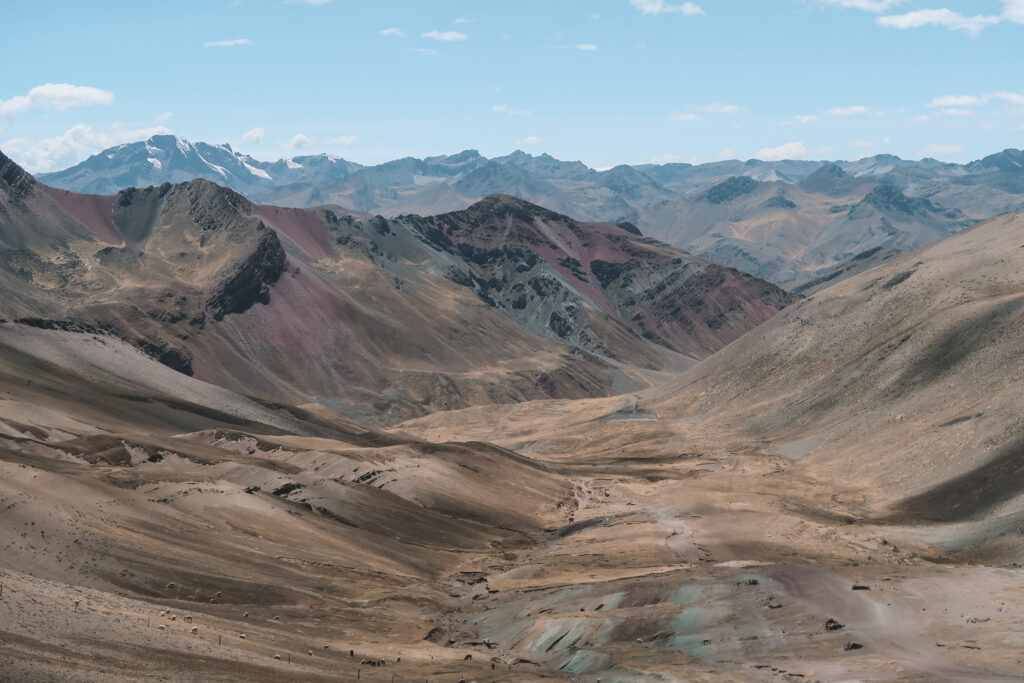
Day trip logistics
The day trips that the tour operators run to Rainbow Mountain are long, grueling, and start at an ungodly hour.
While some providers might do things a bit differently, here’s an example of how most tours are scheduled:
- Pick-up from your hotel between 4:00 am and 4:30 am
- 2-hour drive
- Quick stop for breakfast in the town of Cusipata
- 1.5-hour drive to Rainbow Mountain trailhead
- Uphill hike to the viewpoint (1.5-2 hours)
- ~20 minutes to enjoy the view from the top of Rainbow Mountain
- Downhill hike back to the bus (1 hour)
- 1.5-hour drive to Cusipata
- Quick stop for lunch
- 2-hour drive back to Cusco, arriving between 4:00 pm and 5:00 pm
(This was the exact schedule we followed on our Rainbow Mountain full-day tour with Inka Altitude!)
To summarize, that’s 7 total hours of driving on winding, bumpy roads at a high elevation. Honestly, I was exhausted before we even started our hike. In addition, because most day trips follow the same exact schedule, you’ll be arriving (and hiking) at the same time as every other tour group — meaning the crowds are inescapable.
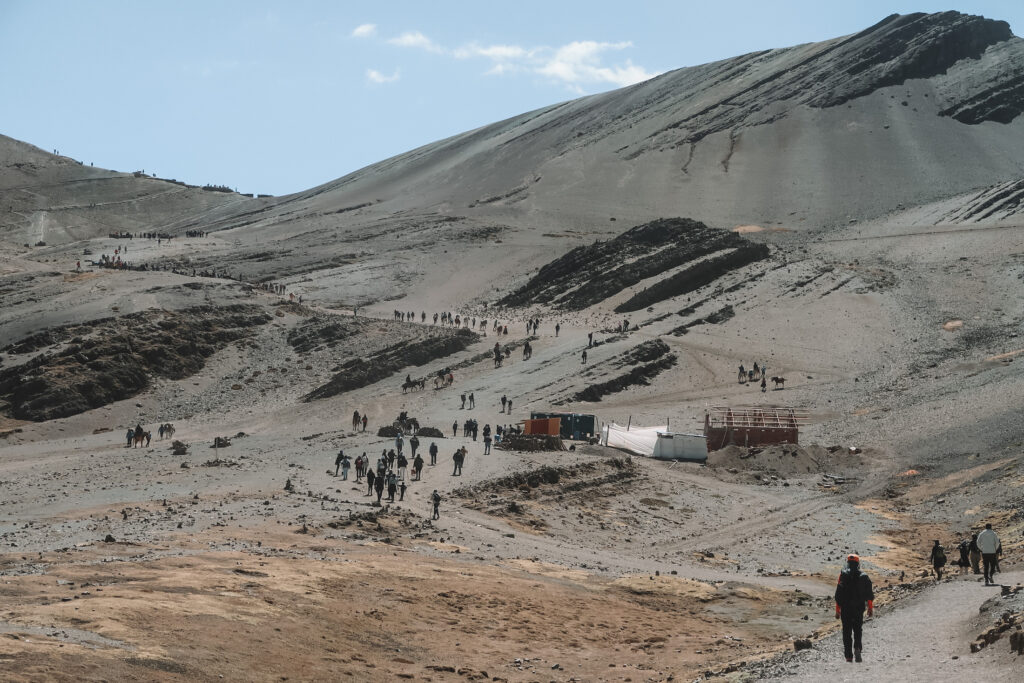
Guided tour vs. independent travel
While I would usually recommend going at it alone for the most flexibility, visiting Rainbow Mountain South America presents certain challenges that make independent travel more difficult.
The first challenge is getting there. Public transportation options are limited — you’ll first need to take a 2-hour bus from Cusco to Checacupe, then a 2-hour taxi to the trail head. Getting to Rainbow Mountain from Cusco is easier if you have your own rental car as you can simply tackle the 3.5-hour drive yourself.
The second (and more concerning) challenge is not having a tour guide around if something goes wrong. Dealing with the symptoms of altitude sickness alone is no easy feat! Besides telling you about the mountain’s history, your guide is there to make sure you make it up and down the mountain unscathed. They carry coca leaves, oxygen tanks, and first aid kits to help you if you need it — and a lot of people do!
For these reasons, I’d recommend booking a tour if you decide to hike Vinicunca. Our Rainbow Mountain tour cost $29 USD and came with transportation, meals, and the reassurance that our guide would help us should we need it.
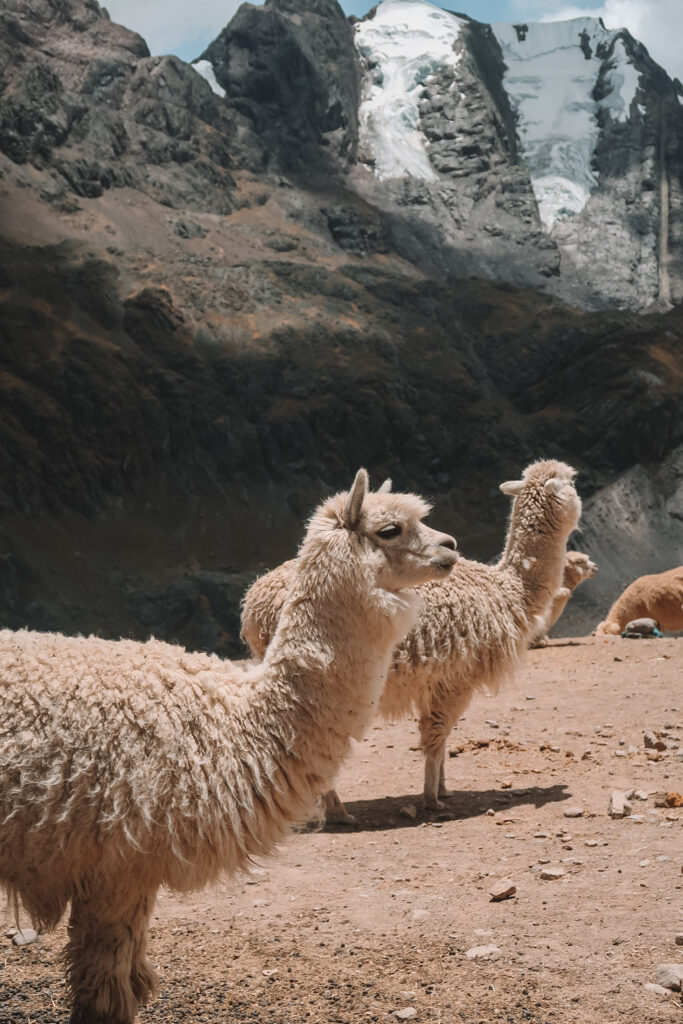
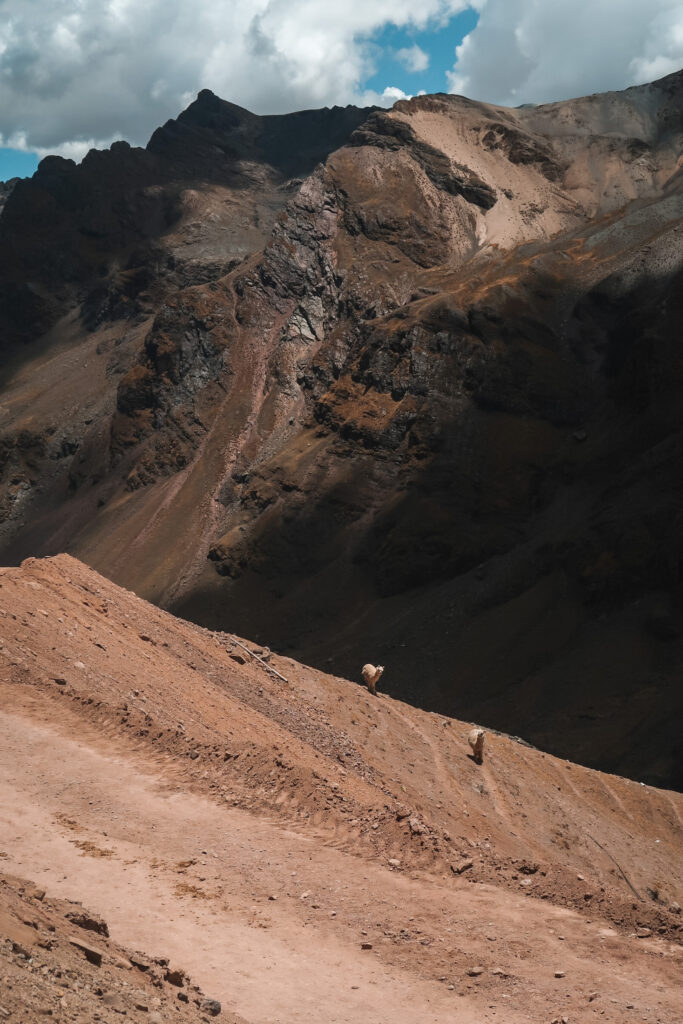
Weather
Pro tip: Make sure to check the weather forecast before heading out to Rainbow Mountain.
According to multiple sources, the day trip is absolutely not worth doing if the weather conditions are bad. Rain, clouds, and fog will just obscure the view and turn the colorful mountain grey. If the hard slog doesn’t end with good views, was it even worth it? (Nope.)
The best time of year to visit Vinicunca Mountain is during the dry season (March through November). This isn’t a hard and fast rule, though — we visited in the rainy season and had stellar weather.
Altitude sickness on Rainbow Mountain
Underestimating the higher altitude is the single biggest mistake you can make when embarking on the Rainbow Mountain trek. Any kind of physical exertion at 5,200 m (17,060 ft) is no joke, and can even be dangerous if you push it too far.
The best way to avoid altitude-related illnesses is by taking your time acclimatizing properly before beginning the hike. This means allowing yourself plenty of time at lower elevations and giving your body enough rest days so that it can adjust gradually. Don’t head up to Rainbow Mountain if you’ve just arrived from Lima — give yourself a few days in Cusco to acclimatize first.
It’s a good idea to drink plenty of water during your ascent as dehydration can spell disaster. At the top of the mountain, you’ll find locals selling coca tea, which is another great way to lessen your symptoms. Chewing on coca leaves or eating coca candies on the way up helps, too.
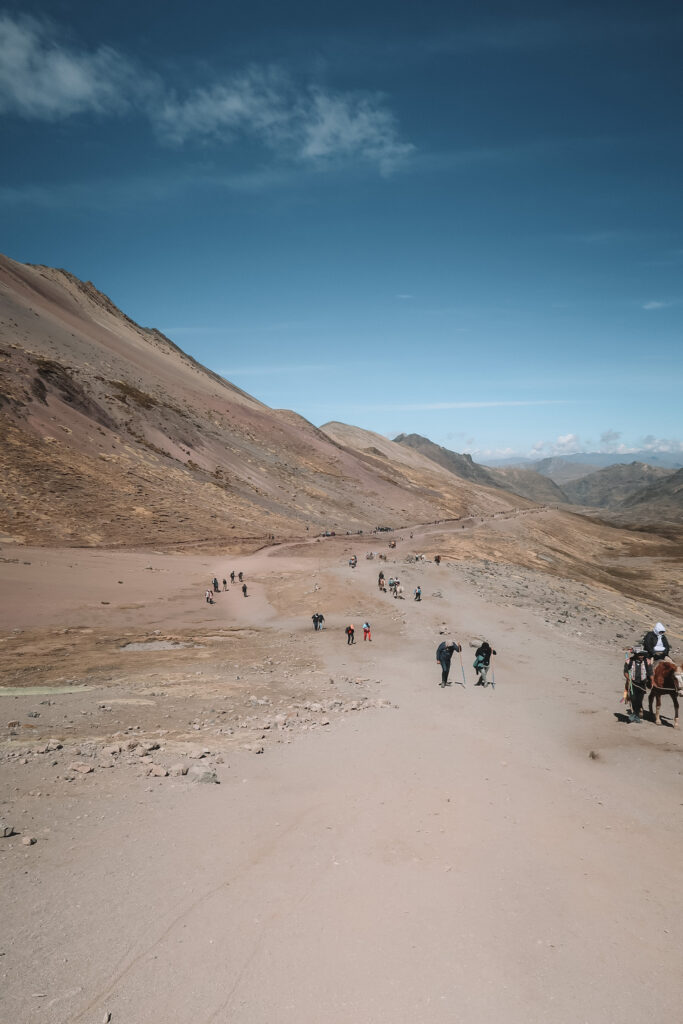
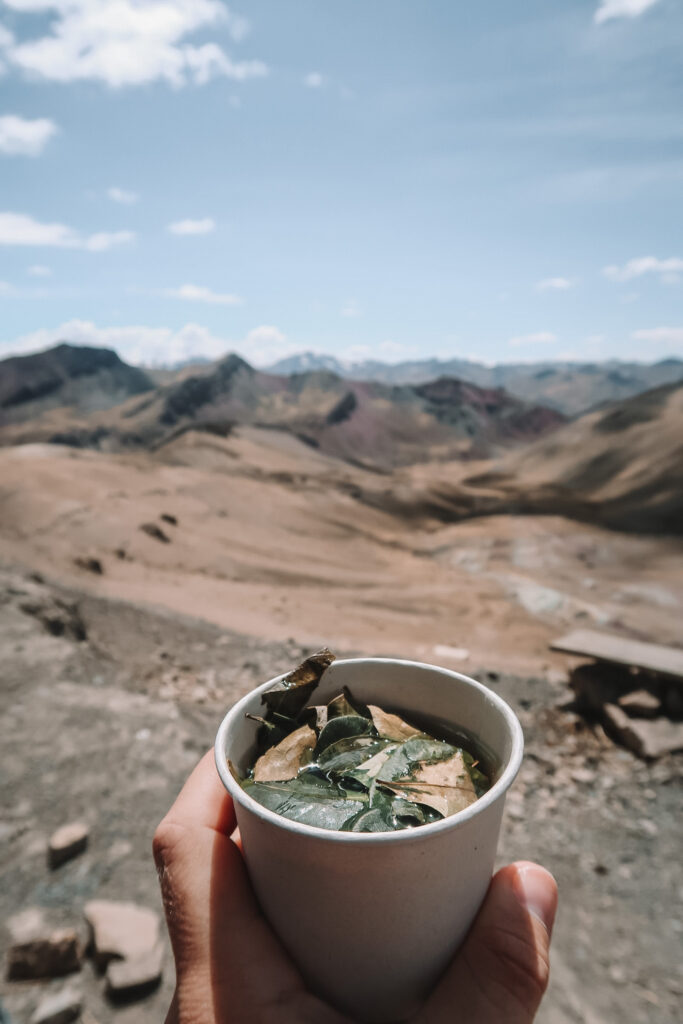
The Rainbow Mountain hike experience
Starting the trek
Our tour started the way that every other tour starts — at the crack of dawn. After a seemingly endless early morning bus ride, we stopped for breakfast at a cute restaurant in Cusipata. I have no complaints about either of the meals we were served — they were tasty and filling.
After another final stretch of driving, this time over gravel roads and pot holes, we reached the Rainbow Mountain parking lot. By this point, I was already tired from the early morning and 3-hour drive. Our tour guide collected our entrance fees (an additional cost of S/10, roughly $2.60 USD) and gave us a quick run-down of how the hike would work.
Everyone in our group was able to go up the mountain at their own pace. Our guide followed behind to make sure we all made it without passing out (awesome!). There was a certain time by which we had to be back at the bus, but other than that, we were pretty much on our own.
Hiking Rainbow Mountain
The hike itself, if it were at sea level, would not be difficult at all. For the first 45 minutes, the trail is mostly flat. After that, it turns into a gentle slope, and then into a pretty steep slope for the last push to the top. Most everyone will be able to finish, assuming you have a reasonable level of fitness and walk at a steady pace.
For some reason, though, some people experience the effects of high altitude more than others. (It’s me — I’m some people.)
Despite all of my best efforts (i.e. acclimatizing in Cusco, drinking coca tea, and going on hikes fairly regularly) I felt like total shit the whole time. From the starting point, I was breathless and irritated. The headache that I had on the bus ride back to Cusco was bad enough to put me off of high altitude hiking forever.
If this also happens to you on the mountain and you feel like you can’t make it, there is a solution. The local Pampachiri indigenous community has capitalized on the trend of exhausted tourists and will give you a horseback ride up to the top (for a fee).
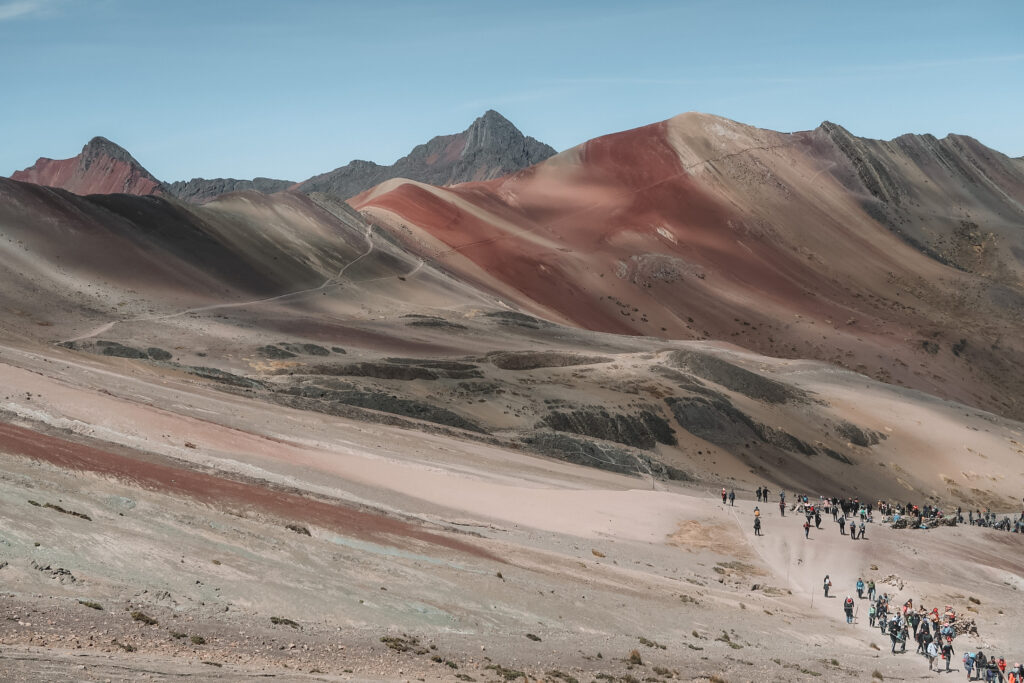
Animal welfare & local communities
One of my main problems with the Rainbow Mountain hiking trail is the increasing use of horses to carry tourists up and down the trail.
As more and more people flock to this popular destination, demand for horse rides will go up. This places a great deal of strain on the animals, and there are no guarantees that these horses are healthy or well-treated. They may also be forced to bear heavy weights beyond their capacity.
We should definitely be wary anytime animals are used to support large-scale tourism. All of us have heard about what goes on at SeaWorld, right?
And the negative impact isn’t just on the horses, either — the local people that guide the horses are pressured to run as fast as they can in order to make more sales. More trips up and down the mountain equal more customers, which in the end equals more money.
Normally, more money in the pockets of local communities would be a good thing. In this case, though, the rapid growth of tourism at Rainbow Mountain is unsustainable and mostly unregulated. Individual members of the nearby indigenous communities may be making money, but at what cost?
If you are struggling and feel like you need to ride a horse to make it to the top, make sure it’s one that looks well taken care of. Rides are offered at the start of the hike for S/80 (about $21 USD). The horse will take you most of the way, but you’ll need to walk the last steep portion yourself.
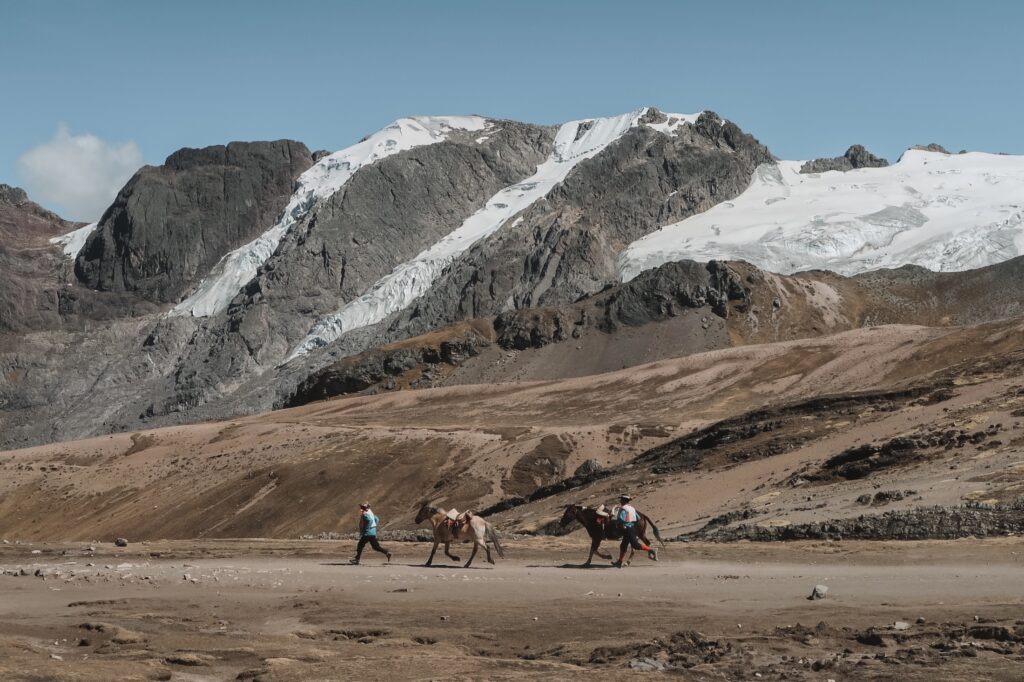
Overtourism
It was hard not to notice the massive crowds that were sharing the trail with us.
From the start, it seemed like there were simply too many people there. Unlike Machu Picchu or the Inca Trail, there is no cap on daily visitors to Rainbow Mountain. Tourists have already caused erosion along the trail leading up to the peak, with some parts becoming almost unrecognizable from their original state due to heavy foot traffic.
The surrounding ecosystem is incredibly fragile, meaning any damage caused by overtourism can take years to repair.
Since the mountain’s spike in popularity, a new parking area was built into the nearby wetlands to accommodate the rush of tour buses. This shortened the length of the trail for tourists, but displaced tons of native birds in the process.
In my opinion, these sacrifices to the environment aren’t worth it. If tourism to Rainbow Mountain continues at the rate at which it’s been going, the natural beauty won’t be around for much longer.
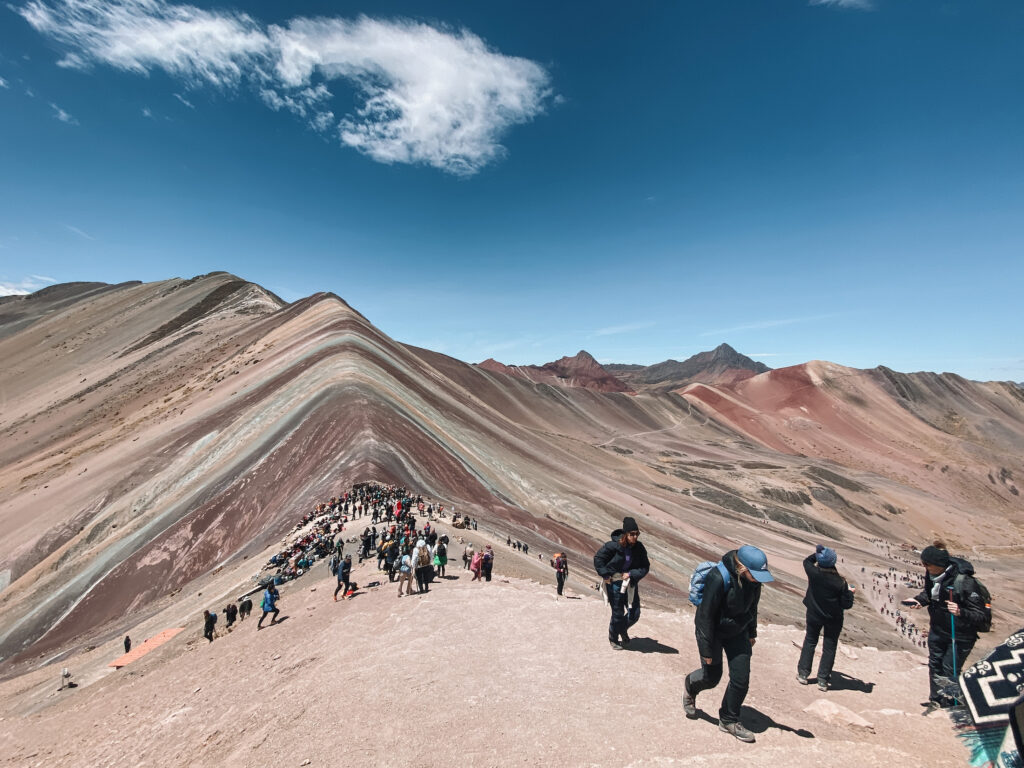
Alternatives to the Rainbow Mountain hike
Luckily, several similar (but more ethical!) hikes exist in and around the Cusco area. These hikes also offer stunning scenery and the chance to see unique, rainbow-striped peaks.
Palcoyo Mountain
Palcoyo Mountain is known as the “alternative Rainbow Mountain” because of its similarly colored rainbow stripes. The Palcoyo Mountain day trip from Cusco has far fewer crowds and reaches a maximum altitude of 4,880 m (16,000 ft).
Pallay Punchu (Apu Taqllo)
The Pallay Punchu mountain hike is a moderately challenging trek located about 4 hours away from the city of Cusco. This rainbow-striped mountain also looks very similar to Vinicunca and overlooks the beautiful Laguna Langui, one of the largest lakes in the Cusco region.
Ausangate Trek
Ausangate is a strenuous, multi-day trek over 69 km (43 mi) that crosses through glacial valleys, limestone forests, and shimmering alpine lakes. If you’d like, you can also choose to visit Vinicunca Rainbow Mountain as a side excursion. The Ausangate Trek can be done with or without a guided tour, but most people choose to do it with.
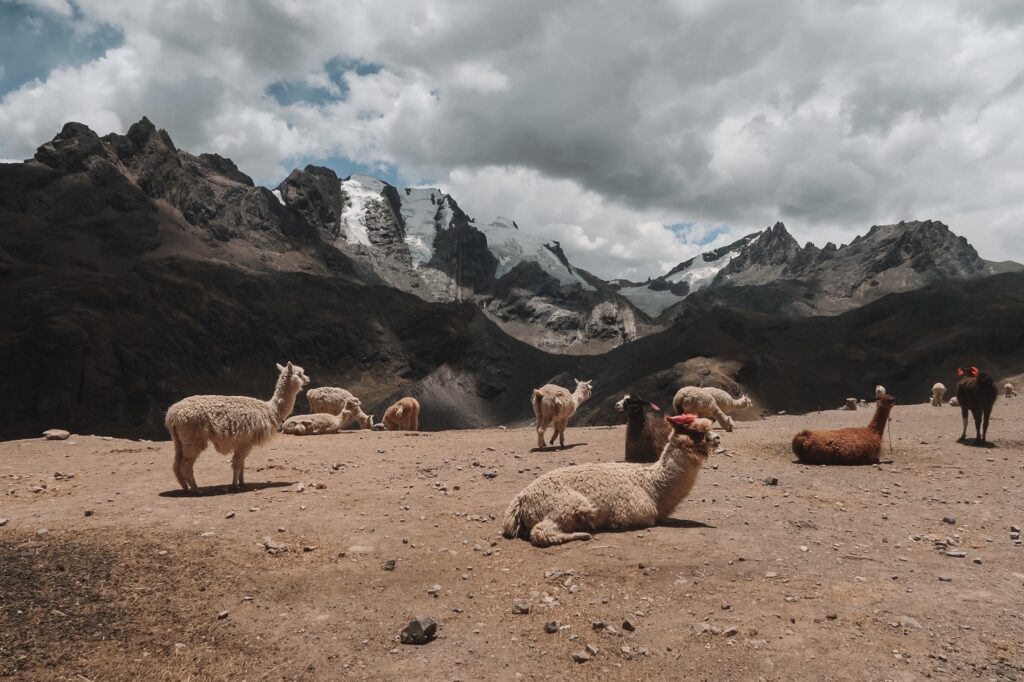
Rainbow Mountain packing list
- Warm clothes: These are a necessity, regardless of the weather conditions or time of year. At the very least, bring a hat, a pair of gloves, and a warm windbreaker.
- Sunglasses: There is a lot of glare on the track, especially on a sunny day.
- Hiking poles: These are not a necessity, but can be super helpful on your Rainbow Mountain day trip.
- Toilet paper: There have been improvements to the toilets on Vinicunca in recent years, but they still leave a lot to be desired. Make sure you bring some toilet paper with you because you’re not guaranteed to find some!
- Cash: You’ll need it if you want a horse ride to the top, a refreshment on the summit, or a picture with one of the funny alpacas.
Rainbow Mountain FAQ
How difficult is the Rainbow Mountain hike?
The Rainbow Mountain hike itself is not too difficult, but the high elevation makes it way harder. Most reasonably fit people will be able to make it to the summit if they pace themselves.
Before embarking on the hike, it’s important to acclimatize yourself to the altitude by spending a few days in Cusco. Drink plenty of water and chew on some coca leaves to help you during the walk.
Can you hike Rainbow Mountain on your own?
Yes, hiking Rainbow Mountain is possible on your own — but I wouldn’t recommend it.
Going with a tour group means that all of your travel logistics and meals are taken care of. You also have a guide whose job it is to make sure you make it up and down the mountain safely.
If you do decide to visit Rainbow Mountain, I’d recommend going with a highly-rated tour like this one.
When is the best time to visit Rainbow Mountain Peru?
Peru’s dry season (March through November) is the best time to visit Rainbow Mountain. If you visit during this time, you’re more likely to have good weather during your hike. You can also expect it to be more crowded, but it will likely be busy no matter what time of year you visit.
Is the Rainbow Mountain hike worth it?
This is a tricky question to answer, but ultimately, I’d say no.
Not only did I feel physically unwell because of the high altitude, but I also felt like I was contributing to overtourism in a very obvious way. While the views were beautiful, I don’t think they were worth the exhaustion and discomfort I felt during the full day tour.
I’m glad I did it for the experience, but I would definitely never do it again. Instead, I would look to the alternative hikes I have listed above.
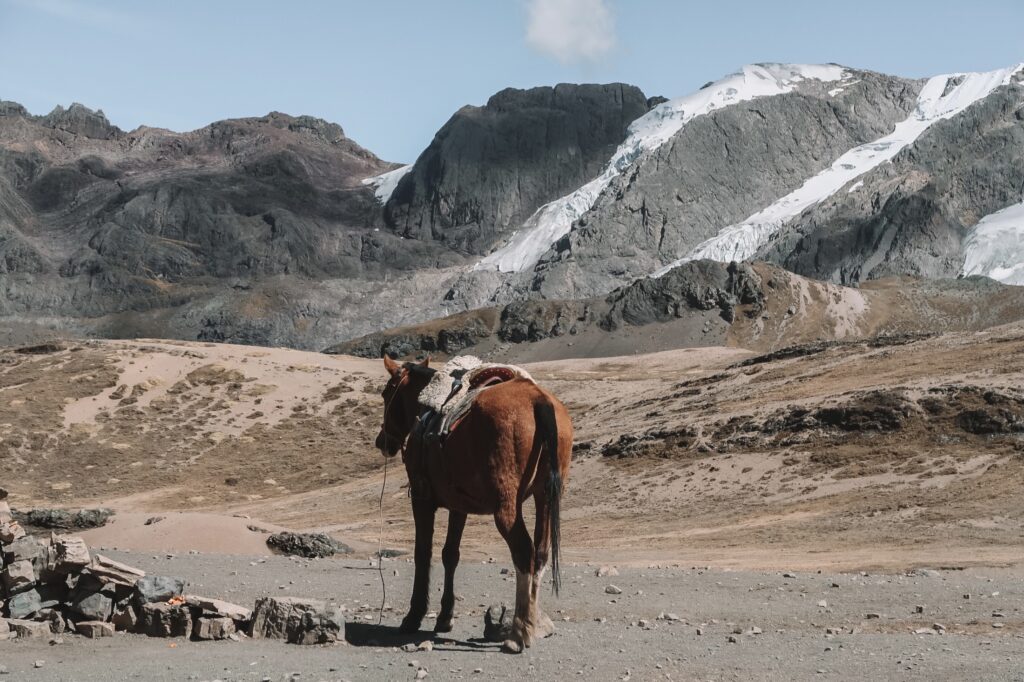
You’ll also love:
- Iceland Golden Circle Itinerary: The Ultimate Self-Drive Travel Guide
- Hiking the Lake Benmore Peninsula Track
- How to Visit Malbork Castle: The Best Day Trip From Gdansk, Poland
Thanks for reading this guide to Rainbow Mountain in Peru! If you’ve done the hike, let me know what you think in the comments below.
xoxo Niki
